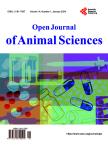Feed Intake, Digestibility, Growth Performance and Blood Profiles of Three Ethiopian Fat Tail Hair Sheep Fed Hay Supplemented with Two Levels of Concentrate Supplement
Feed Intake, Digestibility, Growth Performance and Blood Profiles of Three Ethiopian Fat Tail Hair Sheep Fed Hay Supplemented with Two Levels of Concentrate Supplement作者机构:Department of Animal Sciences College of Agriculture and Natural Resources Debre Markos University Debremarkos Ethiopia School of Animal and Range Sciences College of Agriculture and Environmental Sciences Haramaya University Dire Dawa Ethiopia Agricultural Transformation Agency Addis Ababab Ethiopia
出 版 物:《Open Journal of Animal Sciences》 (动物科学期刊(英文))
年 卷 期:2017年第7卷第2期
页 面:149-167页
学科分类:1002[医学-临床医学] 100214[医学-肿瘤学] 10[医学]
主 题:Blood Hematology Linear Body Measurement Serum Biochemistry Sheep
摘 要:An experiment arranged in 2×3 (2 concentrate supplement levels (CSL) and 3 breeds) factorial was carried out to evaluate the effect of CSL, breeds, and their interaction on feed intake, digestibility, feed utilization efficiency, and blood profiles of Ethiopian fat-tail hair sheep. The CSL were 1% and 1.75% body weight, designated as L1 and L2, respectively. The breeds used were yearling intact male Blackhead Ogaden (BHO), Horro and Washera. Sixteen sheep from each breed were divided into two based on initial body weight and randomly allocated to two dietary treatments for digestibility and growth trials of 10 and 90 days, respectively. Grass hay as a basal diet was offered ad libitum to each sheep. Feed intake every day and live body weight at interval of ten days were recorded for the duration of the experiment. Blood samples and linear body measurements were taken a week before the end and on the last day of the experiment from all sheep, respectively. Dry matter and nutrient intakes, except concentrate supplement and CP, were influenced by the interaction. The higher (p0.0001) DM digestibility was recorded from sheep supplemented with L2 than L1. Consequently, sheep supplemented with L2 had significantly higher (P0.05) feed conversion efficiency (FCE), average daily gain (ADG) (57.3 vs 44.2 kg), total gain (TG) (5.3 vs 3.9 kg) and final body weight (FBW) than those supplemented with L1. Among breeds, Horro sheep recorded higher (P0.05) DM intake, digestibility, and FCE than the rest of the breeds. Consequently, this breed has significantly (p0.05) higher TG, ADG, and FBW. Some of the blood hematology (PCV, MCV, neutrophils, and monocytes) and sera metabolites (total protein, urea, and cholesterol) values were influenced by the interaction in favor of L2. Hemoglobin concentration was higher for Washera than the other breeds (p0.05). In conclusion, the study indicate the presence of variation in nutrient intake and utilization, performance traits, and blood pr



